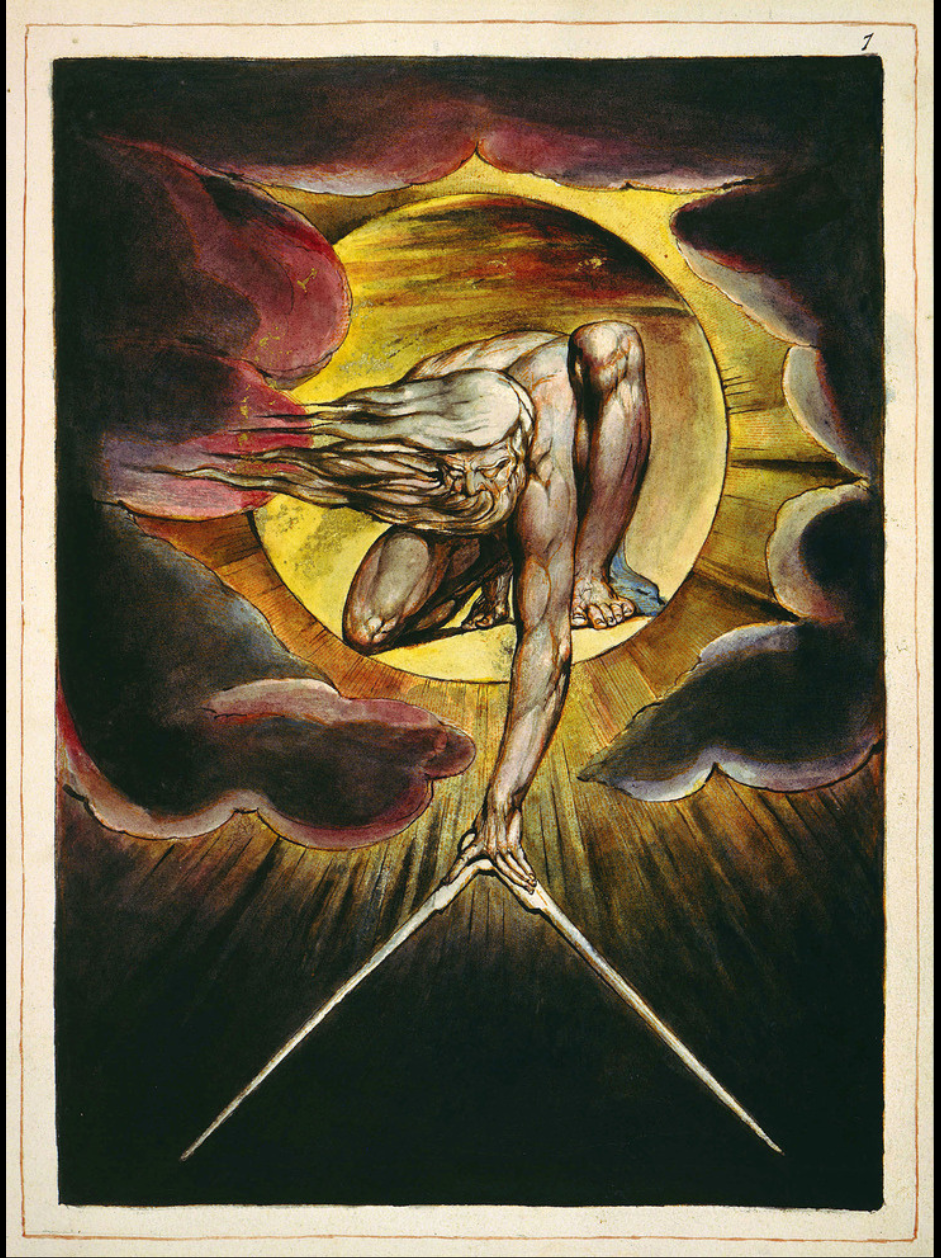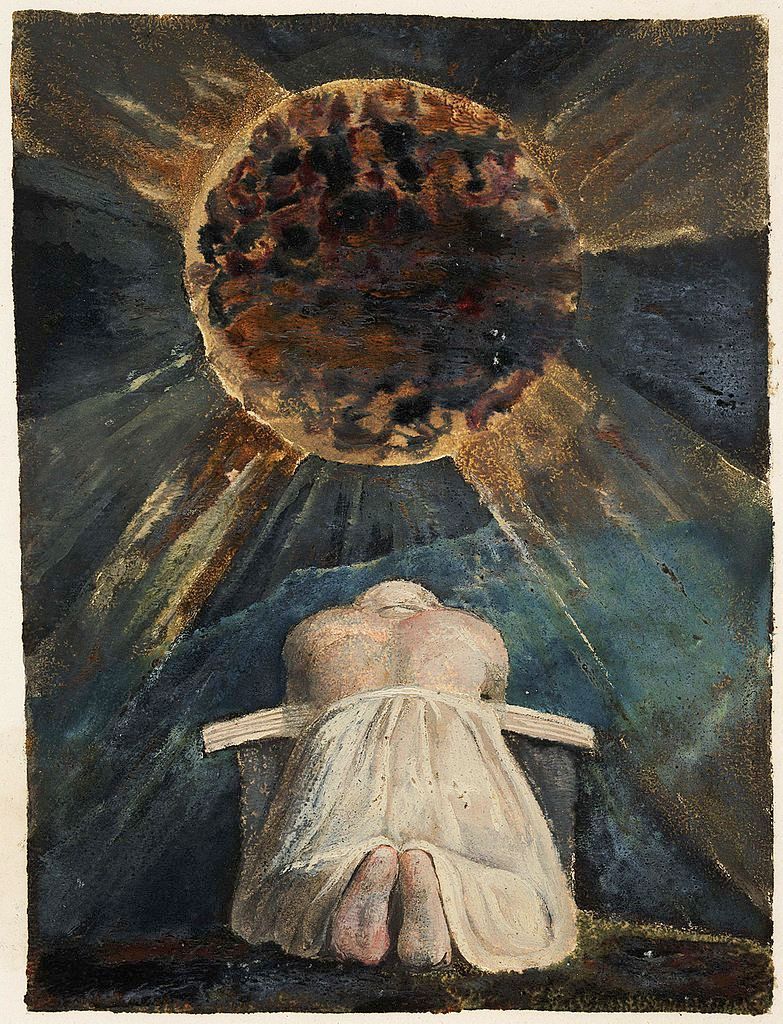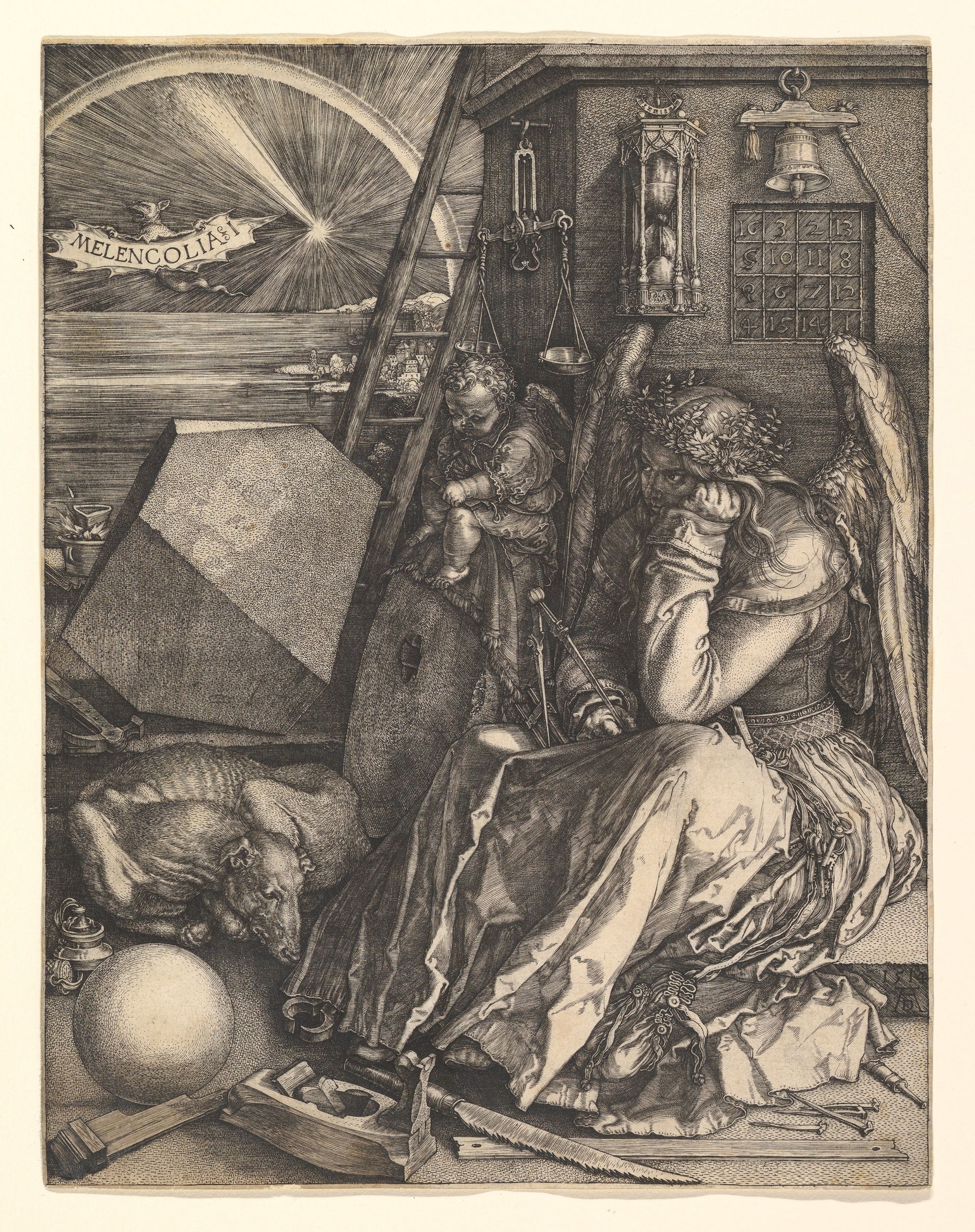


🔱 Mythological system : Universal
🙏 Religion: Pan-religious • Timeless
💡 Symbol Highlight : Fire - God - Divine Self - Royalty
☀️ Positive potential : Divine Masculine / Non-duality
🌘 Negative potential: Minimal.
The Sun is a star that makes up 99.86% of the total mass in the Solar System. This means that the Solar System, which includes planets, moons, asteroids, comets, and other objects orbiting the Sun, is predominantly the Sun itself.
Before we dive into the essence of the Sun and realize its creative potential for poets, artists, and storytellers, it is essential to understand how myths are formed. Enroll in our Evolutive Mythology Course to enhance your creative practices with powerful symbolism & myth.
Join our waitlist.
Now, let’s dive into the symbolism of the Sun with our hermeneutic card based on the Gunas.

The Ancient of Days.
Frontispiece to 'Europe A Prophecy' by the British poet-artist William Blake (1757-1827), representing the enigmatic and solar deity Urizen, one of the main demiurges in Blake's mythology declined in visual art and genius poetry. This illustration mixes many media: printmaking (relief etching), watercolor, pen and red ink, touched with gold, on paper (1794-1821). Source:
The Fitzwilliam Museum, Cambridge UK
For the interpretation method, the NATURE & STRUCTURE OF SYMBOLS & MYTHS, join our Evolutive Mythology Waitlist!
APPLIED HERMENEUTICS : THE SUN
Table of content
PRACTICE (CASE STUDY):
SUN SYMBOLISM
Creative & introspective potential of the sun archetype
HERMENEUTIC GRID OF THE SUN BASED ON THE GUNAS 👁️
Symbolic polarities (Evolution / Regression)
- Sattvic elements of the archetype
- Rajasic elements of the archetype
- Tamasic elements & how to handle them
Right : Apotheosis, a large painting that is part of the Slav Epic (Slovanská epopej), a collection of 20 paintings by Alfons Mucha, one of the leading artists of the Art Nouveau movement. Dive deeper in the solar symbolism of this painting here
ATTENTION
Sattva, Rajas, and Tamas are described in Yogic literature as forces of evolution. Our manifested world is the result of their interplay. Therefore, what we've just explained is valid first and foremost at the existential level, the support of all creative and introspective endeavors. The gunas are not fancy tips and tricks to "boost creativity." They are universal forces of evolution, active in our physical, mental, and spiritual lives. Think of them as the building blocks of consciousness.
AS A CONSEQUENCE, INITIATION INTO AN AUTHENTIC SPIRITUAL PRACTICE IS ESSENTIAL TO FULLY REALIZE THE GUNAS' ROLE
IN OUR INNER AND OUTER LIVES
APPLIED HERMENEUTICS
Solar symbolism: Interpretation grid
From a prosaic or ordinary perspective, the sun is the main source of energy on our planet and in the Solar system. Here’s a surprising fact: although considered a planet, the sun does not have a solid surface! It is a hot plasma sphere of hydrogen, helium, and other heavy elements radiating ultraviolet and infrared light within our galaxy. With a radius 109 times larger and a mass 330,000 times greater than Earth's, the Sun is also much bigger than any other planet or object in the Solar System. In fact, it is so big that if you could fit all the planets inside of it, there would still be room left over! The Sun is a star that makes up 99.86% of the total mass in the Solar System. This means that the Solar System, which includes planets, moons, asteroids, comets, and other objects orbiting the Sun, is predominantly the Sun itself.
Without solar light and heat, which allows life to exist on Earth, our bodies wouldn't be able to function properly. Due to its central role in nature, the sun has been worshiped since antiquity and remains the symbol of the most powerful being in this universe, beneath it, and beyond: God.
Mythology Deck for Creative Contemplation 2024
Archetype # 12: Solar Presence
by poet-artist Murielle Mobengo. Tools for Creation and Introspection
Digital art
HERMENEUTIC CARD: SUN
This Solar hermeneutic card is part of our evolving mythology deck. The sun is a meta-archetype that is generally considered harmonious and life-giving in nature. Only in certain animism which did not reach the transcendental stage of the philosophical/religious experience, like the Mayas, the Aztecs, or certain African animism, is the sun considered negative.
Enjoy these hermeneutic cards on the Heavenly and Royal Sun! Examine them, try to decipher how they've been crafted, what the layers of meaning are. Let them inspire your creativity.
Consider joining our
Evolutive Mythology Waitlist to enroll in our eponym Course where you'll examine the symbolism behind this card and many others, and realize how mythologies are formed, how they benefit the creative life, the intellect, and more generally, the inner life, and what their ultimate purpose is.
GENERAL DESCRIPTIVE LEVEL
Word of caution
⚠️ Resist cryptic and disorderly symbolism
Symbolism involves how shapes can evoke immediate meaning and universal concepts to the inner life, known as "archetypes," and it is not related to mathematics. Resist the trend to mix science with spirituality. Symbolism is an element of the psyche, a metaphysical or spiritual discipline, and an art in itself. It should not compete with mathematics or use approximate science to justify its worth.
Science is the observation and study of external phenomena in nature, while symbolism is a tool to observe the inner life. What symbolism seemingly borrows from science is found in nature. Nature is the common ground between science and symbolism. When developed properly, symbolism naturally harmonizes with logic, so there is no need to fabricate links that are not obvious or do not exist.
As poets and artists, my advice is to focus on mastering the recognition, interpretation, and manifestation of the inner life through symbolism, just as scientists focus on mastering the outer manifestations of nature through their disciplines. Avoid attempting to mix these genres.
⚠️
Use established symbolic / spiritual traditions as a grid
Our hermeneutic cards draw on Yoga / Tantra symbolism because among the many alchemical traditions humans have practiced, Yoga is still practiced and encompasses all the ritual, philosophical, and mystical stages of Religion, beyond race, gender, or geographical boundaries.
Tantra is a Yogic tool and has nothing to do with unbridled sex. In fact, in the elevated tradition of Yoga as codified by Sage Patanjali in the Yoga Sutras, the practice of authentic Yoga to attain self-realization (enlightenment) causes the seeker to naturally control his senses and rise above sex. Tantra signifies "method," but also "chain," "rules," "treatise" etc. Head to your Secret Library for a definition by academic Sanskritists.
In the Yogic perspective, "tantra" encompasses a variety of methods, from studying treatises and performing ritual offerings to practicing devotion, concentration techniques, and chanting mantras. These diverse practices aim to achieve union with the supreme consciousness, which is the essence of Yoga.
Cosmic Yogic knowledge has been transmitted through an uninterrupted chain since its inception. This continuous transmission may not always be the case for Western and Middle-Eastern alchemical traditions, for example. A stronger argument for using Yogic philosophy to decode world symbolism is its universal nature. Yoga is a spiritual tradition of remarkable vitality, practiced by people of all backgrounds, regardless of religious aspirations and lifestyles.
As a general rule, knowledge needs to be active to be effective, not dormant. Dormant traditions, where the transmission of knowledge has been interrupted for generations and protocols have been lost or forgotten, tend to contain inertia (tamas), hindering progress and understanding. The universal aspect of Yoga makes it a powerful tool for symbolic interpretation, as its symbolism naturally harmonizes with initial traditions, including those that may not be perceived as Yogic, such as alchemic traditions from the Middle East or Europe.
Harmonious correspondances:
The solar archetype: A symbol of unity as the source of diversity
The sun is an archetype of the highest order for poets and artists willing to create poetry and art that resonate deeply with audiences, beyond the ages. Ancient Greek philosopher Plato used the symbol of the sun and its absence to help people understand the essence of existence and the importance of an examined and enlightened life through the Allegory of the Cave. Unfortunately, this allegory has poor representations in visual art. We recommend studying this myth directly from Plato's work. Then, why not create your own rendition in poetic or artistic form?
Unlike the many deities of the human pantheon across religions, there is only one sun revered in all cultures, throughout the ages, from the dawn of humanity until this very day. Except for a few ancient animistic mythologies like the Aztec, the Mayans, or certain sub ethnic groups in sub saharan Africa, the Sun is considered auspicious.
In animistic Pygmean, Gaelic, and Irish myth, the sun symbolizes the eye of the divine. In the aboriginal cultures of Australia, the sun is the son of the creator who watches lovingly over humans. Some of these animistic cultures may have predated Greek-Roman antiquity, where the solar planet inspired philosophical treatises (Plato), and religious practices (Pythagoras and mysterious religions).
In Orphism, an ancient initiatic religion devoted to the worship of the poet Orpheus, the sun was worshiped as the intelligence of the world, its natural order.
Vedic mythology and philosophy have the most elaborate solar narratives, with the sun being the incarnation of God, the Universal Self as Shiva in the form of the central sun at the center of universe (where Shiva exists in physical form as a black hole, literally, an inverted sun).
Our extensive evolutive mythology course dives deeper into these to show their universal symbolism and how they have inspired philosophy, art, and poetry over the ages.

The Kornak Sun Temple in Odissa, India has been declared a UNESCO World Heritage Site in 1984. A major pilgrimage temple, the temple is designed as a chariot with 24 wheels. Each wheel has a diameter of 9 feet, 9 inches, with 8 spokes. Source: Wikimedia Commons.

A more pessimistic perception of the Sun. In The Song of Los, William Blake sighs at the regressive potential of the intellect, expressed in duality. Here, Urizen worships the black sun of cold reason which smothers sensitivity, wisdom contained in emotions.
The William Blake Archive is a fantastic resource to dive into Blake's mythological system, the source of his poetry, art, and philosophy. Use the"Diplomatic Transcription" function to read the poem. Source: The William Blake Archive

Melancholia I, the evocative engraving by Albrecht Dürer (1514), loaded with Eastern and Western symbolism. Here's an assignment to develop your symbolic thinking and sensitivity. 1/ List each element of the engraving. 2/ Identify their symbolic source (Eastern or Western). 3/ Interpret them using the Hermeneutic method. Source: Wikimedia Commons.
Creative & Introspective Power
Storyteller tools: How to harness the solar power in your poetry & art
🔥 Poets & Artists: Here are pointers to help you tap into the solar archetype to introspect, enhance your creations with universal meaning and beauty, and connect on a deeper level with your audience:
- In your visual art, poems, or lyrical stories, use the sun archetype each time you want to express reason, the divine, impersonal and absolute qualities–these are synonyms–or a sense of nobility, royalty, brilliance, perfection, reason, radiance, warmth, sweetness, order, happiness, victory (See Mucha's symbolism). All of these are divine qualities.
- The sun's source elemental, fire, evokes the 3 stages of life or consciousness; primal transformation, creative energy, and destruction. We'll publish the 5 elements hermeneutical card soon. Watch your Mythological Vault often.
- Archetypes are universal symbols that mysteriously bare incredible resonance in human beings, regardless of their origins. They carry ancient meaning ingrained in our culture by the First Storytellers, authors of the first cave paintings, cosmogonies, and sacred literature. Time, the foundation of tradition, certainly aided in the constitution of this eternal memory, as every generation tends to build on the legacy of the previous one. The sun is a powerful symbol of cyclic temporality (perception of time). Study the cycles of time in Lemurian Scrolls. This new mythology is a central part of our Evolutive Mythology Course. Because it is dense, we recommend a guided study of the Scrolls to reap maximum benefits in terms of creativity. Consider joining our Evolutive Mythology Waitlist.
- In its harmonious and superior narrative form, the solar archetype family represents spiritual enlightenment (upon which the enlightened, genius-expressing intellect depends), the divine Self, kingship, nobility, dignity, and purity.
- Use the absence of the sun, or the moon, to convey opposite existential perceptions in your poetic/artistic narrations. The archetype of the moon is not an absolute solar opposite, as the lunar and nightly realm also evokes introspection, a positive aspect. However, stories that take place at night or when the sun is absent tend to create a sense of oppression. Use these opposites to denote the tension of transformation.
- Remember that in Samkhya, Harmony is the first aspect of reality, and the source of genius. Therefore, master your narrative: Avoid poetic narrations and art depictions that indulge in darkness (inertia, ignorance). Always use dark/obscure symbolism in contrast with light/luminous archetypes to help your audience develop discernement, develop a taste for clarity, grow into knowledge and rise above ignorance. Be benevolent and precise in your written or visual work, always. It is a spiritual responsibility.



